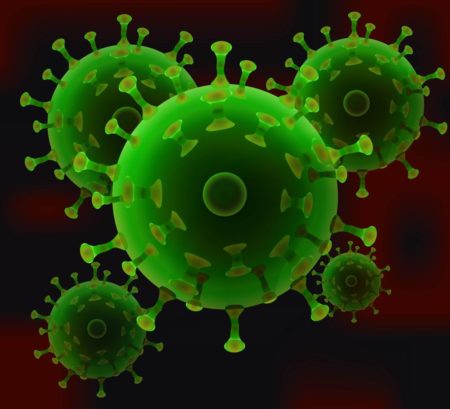Virus Versus Vaccine describes the current research dilemma as research scientists around the world race to defeat the current outbreak of novel coronavirus.
You might know that, As of Feb. 11, authorities changed the name of the deadly pneumonia-like disease plaguing the planet. They changed it from novel coronavirus to COVID-19. First, in this blog, the Doctors and staff at Florida Lung, Asthma and Sleep Specialists bring you the latest updates and data on this disease. Then, we report on how the experts say to avoid infection, not only from Covid-19 but from a far greater danger.
Virus Backstory: The Basics

COVID-19 is So Contagious That Expert Care Must Be Taken by Researchers Working on a Vaccine.
The novel coronavirus that’s to blame for the illnesses began in the Chinese city of Wuhan. Now, as of Feb. 21st, the lethal virus has claimed the lives of at least 2,250 people, world-wide. It has sickened at least 76,000 people.
The disease has spread to at least 29 countries — including the United States. “Hundreds of Americans have been evacuated from the city on State Department-chartered flights… And, at present, they “are completing quarantine orders at several military bases.”
The latest word from the CDC “maintains that the risk to the U.S. public is currently low.” But that could imminently change, as day by day, the infection continues to spread.
Virus: Know Your Enemy
Did you know that Coronaviruses are a large family of viruses that can cause other medical conditions?
- They can cause many types of illnesses, “from the common cold to Severe Acute Respiratory Syndrome. (SARS)
- SARS, as you might remember also originated in China. It infected 8,000 people and at least 770 died.
- It is also noteworthy that Coronaviruses spread between animals and people. This means they are zoonotic. Officials have said the current outbreak COVID-19, might have begun in the Chinese live markets for seafood and animals.
Virus Alert: Review the Signs of COVID-19

COVID-19 Attacks the Respiratory System with Symptoms of Coughing and Shortness of Breath.
Fever, cough, and shortness of breath are the primary symptoms of COVID-19. And the Director of the National Institute of Allergy and Infectious Diseases, Anthony Fauci, has warned us that the symptoms are very similar to many other respiratory infections.
He recently said, “Most U.S. residents experiencing symptoms are likely infected with the flu or “some other virus…”
He added, “But if they came from Wuhan, it’s likely to be the new coronavirus. And he explained, “The symptoms are very common to a number of viruses.” The actual determination is based on epidemiology and is confirmed by a test referred to as the “rRT-PCR test…”
Virus Versus Mystery: How To Fight COVID-19
Dr. Fauci stated, as a coronavirus, COVID-19 is in the same family as SARS. It has some of the same molecular homologies as SARS. It’s closer to SARS than it is to MERS. But it isn’t overwhelmingly close.”
So research scientists have been working furiously to break the code within this virus. He also explained, “We got the [genetic] sequence from the Chinese. We’re partnering with a company called Moderna to develop a messenger RNA–based platform for a vaccine.” We will likely have a candidate in the early phase I trials… in about three months.” That doesn’t mean we will have a vaccine ready for use in three months.” He added that “even in an emergency” conditions it would take a “year or more. But we’re already on it.”
Virus Versus Vaccine Research

This is the Virus. Notice the Sucker Shaped Spikes. When They Touch a Human Cell, They Invade and Try to Destroy It.
Today, Feb. 21, 2020, there is breaking news in the area of vaccine research, from the University of Texas. Jason McLellan is a UT associate professor of molecular biosciences. He and his team of researchers have created the first 3D atomic-scale map of the spike protein.
- The spherical virus has a multitude of these spikes protruding from its surface.
- This is important because the pretty mushroom-shaped spikes are the part of the virus that attaches to a human cell.
- It’s the key that unlocks the cell and penetrates it to cause infection.
Discovery at University of Texas:
We have discovered that McLellan and his colleagues had “already spent many years studying SARS and MERS, viruses that are in the same family as the new coronavirus and have caused outbreaks in the past. The researchers already had developed methods of locking coronavirus spike proteins into a shape that made them easier to analyze. When they received the genetic sequence of COVID-19 from the Chinese, they knew exactly what course of action they needed to pursue.
The First Steps and Excitement Building for a Vaccine
Only two weeks later, the UT team designed and produced samples of their stabilized spike protein just two weeks after they got the genome from the Chinese. Consequently,12 days later they had created a 3D atomic-scale map of the spike protein. They quickly submitted the manuscript to the journal. This hastened the peer review process. All of these steps would normally take months.
To put it simply, McLellan reported that the new molecule they discovered in the spike “could effectively turn them into candidates for vaccines.” Thus, FLASS is encouraged to see that the world of research is working at a rapid pace to create an elusive vaccine against COVID-19. We are encouraged in spite of the news that many experts report that a vaccine is 18-24 months away, even with the strong push to complete research and testing.
The Next Step in Developing a Treatment or Vaccine
Now the team will use its molecule as a probe. They will be able to isolate “naturally produced antibodies from patients who contracted the new coronavirus and successfully recovered.” Thus, the researchers believe, “the antibodies could help treat a coronavirus infection soon after exposure.”
This is very similar in concept to the anti-viral medicines we use to treat the flu. For example, a prescription may be available for the regular flu if you call your doctor within 24 hours of becoming infected. But that is a treatment, not a preventative vaccine.
Virus Versus Warmer Weather
Interesting comments have been published on the coming of warmer weather versus the spread of the virus. You see, “…Many respiratory infections, including COVID-19, are spread in droplets that are released when an infected person coughs or sneezes.” Therefore, when the air is cold and dry, the droplets travel in the air further and longer. Thus more people catch the infection during cold weather.
So we must ask, “Will the coming of spring kill off the virus?” Experts say, “It’s entirely possible that we might get a spring-time lull…” and “It’s unlikely to make things worse. But we don’t know for sure. – It’s an educated guess.” However, the dark side of that news is that COVID 19 could return in the winter.

To Cure COVID-19, scientists Are Working with at the molecular level , seeking Microbiological, Chemical, and Physical Answers.
This is an ongoing story, and FLASS will continue to update you as the researchers continue their quest to find a vaccine.
But meanwhile, are you aware you face an even greater threat, a more present danger, from the more common flu? Have you had your flu shot? Do not take the risk. It is still not too late to avoid or lessen the danger of the flu.
And, remember simple, health-wise precautions such as rigorous hand-washing can help protect you from all viruses. Thank you for reading the FLASS blog, and please return for more information as this story develops.

